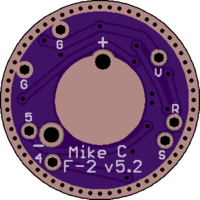If it works is all that matters. If you figured out a way to “calibrate it” that that should work great!
Personally while trying to keep it as compact as possible is a must have goal, I would by no mean limit it to a tiny25. No existing driver will work as is and in most cases people would rather get a new driver that supports it then try to mod an existing driver. Plus for existing tiny25 drivers you would also have to add a resistor before the diode to make them stable at high currents which is even more fun.
I see us moving to an MCU with at least 8kb of rom within the next year in all new designs. So we might as well take advantage of that. Also, I would look into the 841 MCU as that is the most likely candidate. Any code that can be done in such a way as to be easily ported over to it would make the switch easier.
That said, leaving some extra space for future updates is very wise, so optimized code is very good indeed.
As far as the 98% thing. I am a big picture guy. I look at things to see what kind of far reaching effects they can/will have.
I see this as a major leap forward in driver design with more possiblites then even I can think of at the moment.
With things like this you are always better off having more options then fewer. You can easily take options away but adding them is far far harder once it starts to be adopted.
On the very basic level most flashlight manufactures all go with a basic 3 mode setup or propitiatory firmware just because other options don’t offer anything tangible that they can advertise.
This on the other hand would add no cost but a ton of features and real world benefits that they can advertise. I could easily see a stable firmware/driver combo like this turning into something of an arms race as manufactures adopt it to not be left off the bandwagon.
That means it would be a rare opportunity to get our ideas into the mainstream, be it on a small or large scale. IMHO, we should grab this chance by the horns and try to get some proper firmware into the mainstream. It only makes our lives better.
It is also something that if 1 adopts it, then others will as well in order to not fall behind. Until there is something worth adopting though none of them will. Just look at the A6 and bistro drivers. They went from nothing to now being used in virtually all of astrolux’s lineup in the space of like a year. This is something that could have far wider reaching potential.
For this to happen the more features and options, the better. Features sell lights. Lights that sell are what manufactures want.
For example if convoy was to offer a driver with our hardware design and this proposed firmware, it would truly become a no-mod needed flashlight company. The only thing there would be to change would be the LED. He would still make even the most basic user happy all the way up to the most advanced.


